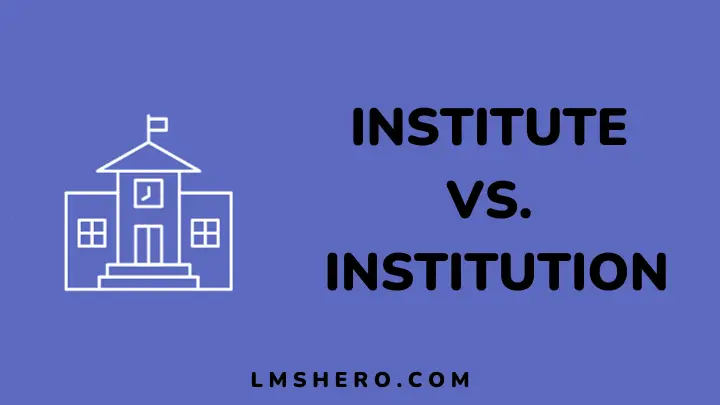Are you confused about the difference between an institute and an institution? You’re not alone. Often used in education interchangeably, the terms are similar in meaning but have distinct differences.
To help clarify the confusion, this article will provide an overview of the major comparisons between an institute and an institution. You will explore the basics, roles, and significance of each and provide some examples to illustrate the differences.
I will also discuss the structure of both. You can confidently distinguish between an institute and an institution with a better understanding of the two terms.
So, let’s dive in and explore the differences together.
Understanding the basics: “institute” and “institution”
Institute
An institution is a large and complex organization, typically with many branches and a wide domain of expertise. It is broader in scope than an institute and may deal with various disciplines.
In addition to offering educational courses and programs, an institution may also have research and training components. Examples of institutions include universities, colleges, and research centers.
Institution
Conversely, an institution is a broader concept encompassing various organizations with a more comprehensive and enduring presence, including establishments. At its core, an institution provides a foundation of stability within a community.
Whether it’s an educational institution, a financial institution, or a cultural institution, these entities become bedrocks that foster growth, resilience, and continuity.
An institution, irrespective of its specific nature, is an organized and established entity that plays a pivotal role in shaping the dynamics of various sectors. It often implies a larger and more established entity.
Role and scope
Institute
Institutes are crucial in providing specialized education and training to individuals seeking to acquire knowledge and skills in various fields.
In addition to offering technical skills such as engineering and computer programming, institutes are known for offering targeted programs that address students’ specific needs.
Institutes provide education and research opportunities, career guidance, and access to equipment and resources. These resources are essential for success in their respective fields.
Institution
All societies rely on institutions as the foundation for their overall development. Institutions come in many forms, such as educational institutions that provide knowledge and skills to individuals.
There are also financial institutions that facilitate economic transactions and provide access to capital and cultural institutions that preserve and promote the arts, heritage, and values of a community.
These entities play a multifaceted role in shaping and maintaining the societal structures that enable individuals to thrive and communities to flourish.
By supporting and nurturing institutions, societies can ensure that they have the infrastructure they need to succeed and thrive over the long term.
Structure and organization
Institute
Institutes tend to be smaller in size and more specialized in nature, with a distinct organizational structure that is often highly focused. They often function independently or as part of a larger educational system.
Institution
Due to their extensive range of operations, institutions generally have a highly intricate organizational structure. Such organizations may comprise several departments, faculties, or branches, each serving diverse functions and responsibilities.
The different units within the institution may have their own hierarchy, policies, and procedures. In addition, they can operate independently or in coordination with each other, depending on the institution’s objectives and requirements.
As a result, effective management of institutions requires a deep understanding of the interdependencies and complexities of their organizational structure.
Significance in different sectors
Institute
Institutes are prevalent in sectors requiring specific expertise, such as technology, research, and vocational training. They cater to individuals seeking in-depth knowledge in a particular field.
Institutes are designed to equip students with the necessary skills to pursue successful career goals or to enhance their existing qualifications. They also allow networking with other professionals in the same field.
Institution
Whether public or private, institutions play critical roles in shaping and influencing various aspects of our lives. In the education sector, institutions such as schools, colleges, and universities provide students with the knowledge and skills necessary to succeed in life.
In the financial sector, institutions such as banks, investment firms, and insurance companies help individuals and businesses manage their finances and investments.
In the governance sector, institutions such as governments, legislative bodies, and courts establish laws and regulations to ensure societal order and justice.
In the cultural sector, institutions such as museums, libraries, and archives preserve and promote the cultural heritage of societies. Overall, institutions provide a stable foundation for societal growth and sustainability.
Evolution over time
Institute
Institutes, whether academic or vocational, can transform and innovate in response to the evolving needs of industries.
As technology, societal trends, and economic conditions shift, these institutions can adjust their programs and courses to remain up-to-date and valuable to students and employers alike.
This adaptability and flexibility are essential for institutes to remain relevant and effective in today’s rapidly changing and dynamic fields.
Institution
As long-lasting entities, institutions tend to evolve slowly over time while preserving their core values and beliefs. They play a crucial role in shaping a community’s cultural and historical identity by providing a sense of continuity and stability.
Whether it is a government, educational institution, or religious establishment, each institution has a unique history and tradition that contributes to the fabric of society.
From their founding principles to their modern-day practices, institutions play a pivotal role in shaping how a community operates and functions.

FAQs
Are the terms “institute” and “institution” interchangeable?
No. These terms are not interchangeable. While an institute refers to a specialized center, an institution is a broader concept encompassing various organizations.
Can an institute become an institution over time?
Yes. An institute can evolve into an institution, especially if it expands its scope, influence, and longevity within a community.
Do all institutions have an educational focus?
No. Institutions can span various sectors, including finance, governance, and culture. Not all institutions are solely dedicated to education.
Are there notable examples of global institutions?
Yes. Examples include the United Nations (UN) and the World Health Organization (WHO), institutions with a global impact.
Can an institution include multiple institutes?
Institutions often consist of multiple branches or departments, each functioning as a specialized institute within the larger organizational framework.
How do institutes and institutions contribute to societal development?
Institutes contribute by providing specialized knowledge, while institutions play a broader role, influencing various sectors and contributing to the overall development of societies.
Summary
Institutions and institutes are both essential components of society. Although they both serve the same purpose of providing knowledge and guidance, they differ in size and scope.
Institutions are larger and more powerful organizations that have a broader influence on society than institutes. To summarize, institutions are the broader framework, while institutes are the specialized components that make up the framework.
Understanding the difference between the two is important for recognizing their various roles in society and how they can work together to help build a better future.
You can also learn more about the common types of social institution and their functions.
Thanks for reading.







